SUBJECTS
GRADE
Show Results
Real and Ideal: A Closer Look at Westward Expansion
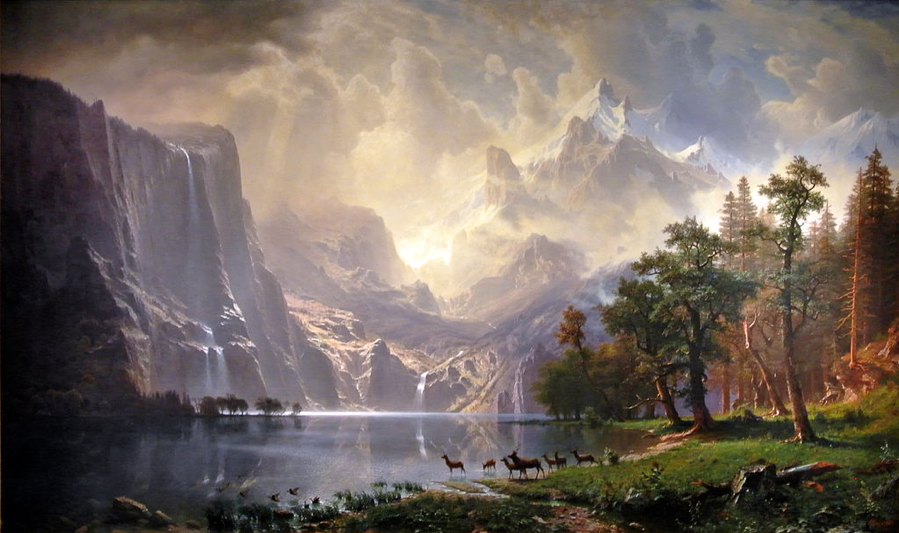
Lesson Summary
- Compare and contrast images that reflect 19th-century westward expansion.
- Photograph portraits that reflect the real and ideal.
Lesson Plan and Procedure
Lesson Key Facts
- Grade(s): 4, 5, 6
- Subject(s): Media Arts, Social Studies, Visual Arts, Native American
- Duration of lesson: 60 minutes
- Author(s): Rachel Jackson
Note: This lesson is one of a group of lessons created to teach about the Transcontinental Railroad through the arts. Titles of the lessons can be found in the additional resources section below.
A PowerPoint document is available in the equipment and materials section and can be altered to meet the needs of your students.
Perceptions of the West
Have students compare and contrast the following images.
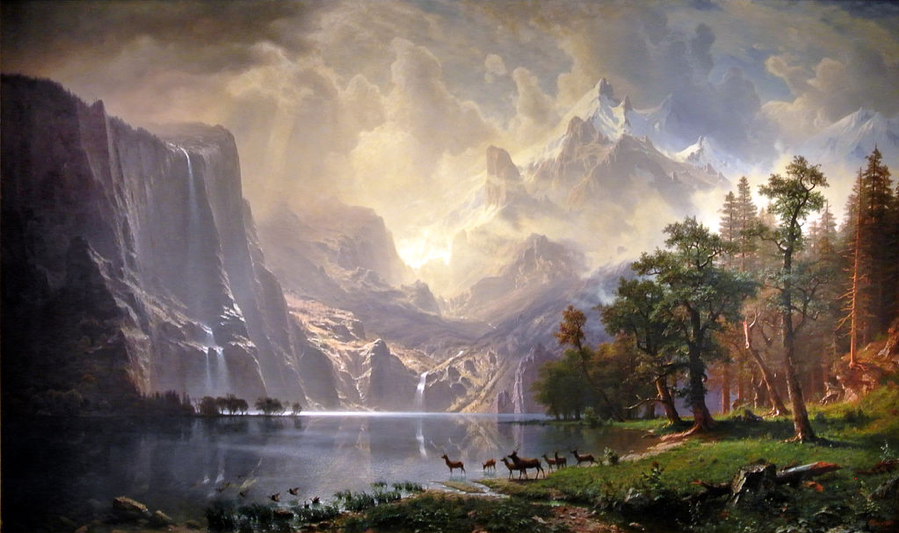
Albert Bierstadt’s Among the Sierra Nevada Mountains, California (1868)

Jackson’s Thousand Mile Tree (1869)
This is the Thousand Mile Tree, a solitary pine in Wilhelmina Pass, or the narrows of Weber Canyon. It marks the thousandth mile west of Omaha on the First Transcontinental Railroad construction by the Union Pacific Railroad.
Have the students fill out a Venn diagram, or draw one on the board and add to the diagram as students give input. Push the students to see the similarities and differences between each of these photos, and have them write down questions they may have.
Group Reading
Teacher: Let’s dig a little deeper to get some background information about these images. The first image was painted by Albert Bierstadt, landscape artist. The second image is a photograph of workers building part of the Transcontinental Railroad. In the mid-1800s, few people had experienced the western United States because there wasn’t an easy mode of transportation. The US government funded the construction of a railroad track that would stretch all the way from Omaha, Nebraska, to Sacramento, California. Each of you will be getting a passage that will give you more insight into one of these images. Use the content to investigate the image. Each of you will be getting a different piece of the puzzle. When you finish reading, you will share what you learned with the class, and we will put the pieces together to understand the bigger picture.
Divide students into groups of eight, and have each group read one of the passages. Because some of the text might be slightly above grade level, consider putting a strong reader in each group. See the PDF titled “Student Readings” in the equipment and materials section.
Give students time to read the passages and decide both what details they will share with the rest of the class and who in their group will do the sharing. Have groups share what they learned with the class.
Romantic Art
Teacher: Now that you have a better understanding of the background of these images, how would you compare and contrast them? What kind of stories do they tell? How are those stories different? Albert Bierstadt was considered a Romantic artist. When you hear the word romantic, most of you probably think of people that are in love. The word romantic has another meaning. Romantic art is a style of art that was very popular during Albert Bierstadt’s time. Artists from the Romantic movement were motivated by freedom. They believed that the path to freedom came through imagination and feeling, instead of logic and reason.
Romantic art can be recognized by some of the following characteristics:
- Full of imagination
- Dramatic
- Mysterious
- Emotional
- Focused on feelings
- Idealized
- Spiritual
- Celebrates nature
The following images are famous examples of Romantic art.
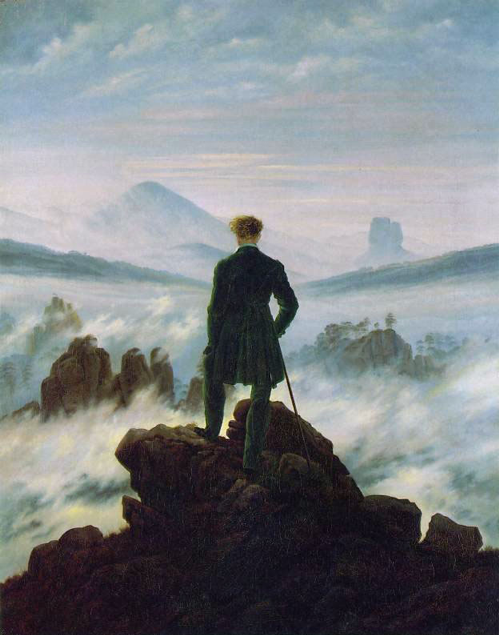
Caspar David Friedrich’s Wanderer Above the Sea of Fog (1818)
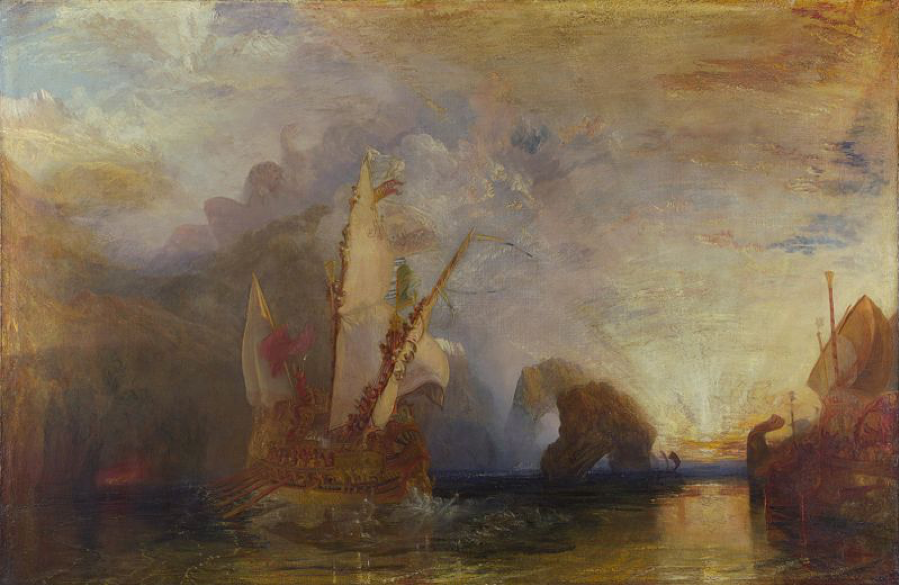
J.M.W. Turner’s Ulysses Deriding Polyphemus (1829)
Teacher: Although Romantic art usually has some realistic traits, it doesn’t always give an accurate depiction of real life. What are some ways that we romanticize our lives? Can you think of images in our day that do this? Today you will be taking photos of yourself. Just like the first two photos we looked at earlier, one will show a glimpse into reality and the other will show the ideal/romanticized you. It can be exaggerated with your imagination. Consider showing what an ideal day at school would look like or what you aspire to be. Your photo can show how you feel about something versus how it is in reality.
Allow students time to complete their assignment.
Here are some photography tips that students can implement with a simple point-and-shoot camera:
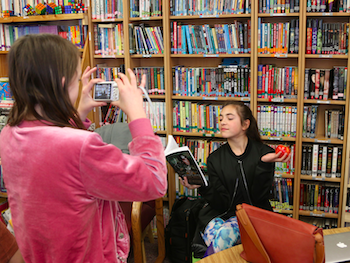
- Hold your camera still.
- Focus on your subject matter.
- Look for different perspectives.
- Shoot at a subject’s eye level.
- Find frames.
- Use leading lines.
The following video is a great resource that explains these photography tips in more depth: https://www.youtube.com/watch?v=tLyOAp3XLLY
Student Examples
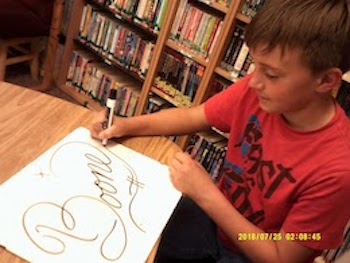
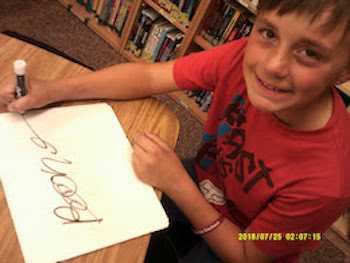








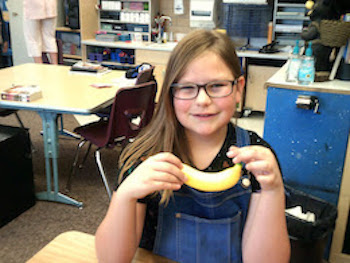
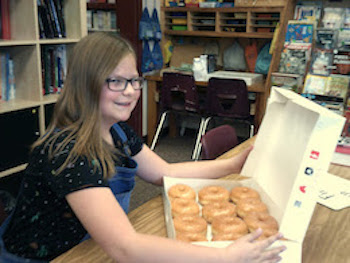


Present Work
Consider putting the photos in a slideshow. Give students the opportunity to show their work to their classmates and explain their photographs. Many students will have most likely exaggerated both of their photos. This is a good opportunity to talk about how the extremes are often looked at in history or in current events, but they usually don’t represent the whole picture. Usually, life is mix between the two, and is somewhere in between.
Learning Objectives
- Understand geographic expansion in the 19th century.
- Assess the impact of westward expansion on Native Americans.
- Evaluate how works of art convey meaning.
- Identify and analyze cultural associations in images.
- Evaluate media messages for accuracy and authenticity.
Utah State Board of Education Standards
This lesson can be used to meet standards in many grades and subject areas. We will highlight one grade’s standards to give an example of application.
Grade 5 Social Studies
Standard 5.4.1: Use evidence from multiple perspectives (for example, pioneers, 49ers, Black Americans, Chinese Americans, Native Americans, new immigrants, people experiencing religious persecution) to make a case for the most significant social, economic, and environmental changes brought about by Westward Expansion and the Industrial Revolution.
Standard 5.4.2: Use primary sources to explain the driving forces for why people immigrated and emigrated during the 19th century, as well as the ways that movement changed the nation.
Standard 5.4.3: Summarize the impacts of forced relocation and assimilation on Native American people and how they have preserved their communities in the face of such adversity.
Grade 5 Visual Arts
Strand: RESPOND (5.V.R.): Students will understand, evaluate, and articulate how works of art convey meaning for the observer as well as the creator.
Standard 5.V.R.2: Identify and analyze cultural associations suggested by visual imagery.
Grade 5 Library Media
Strand 12
Standard 1: Evaluate media messages for accuracy, authenticity, relevance, and source authority.
Equipment and Materials Needed
- Image of Among the Sierra Nevada Mountains, California by Albert Bierstadt: https://upload.wikimedia.org/wikipedia/commons/5/5c/Albert_Bierstadt_-_Among_the_Sierra_Nevada%2C_California_-_Google_Art_Project.jpg
- Image of Thousand Mile Tree in Weber Canyon (1869), provided by the U.S. Geological Survey Photographic Library: https://upload.wikimedia.org/wikipedia/commons/d/d8/1000_Mile_Tree_Weber_Canyon_1869.jpg
- Student readings PDF
- “Real and Ideal” PowerPoint presentation
- Cameras
Additional Resources
This lesson was created thanks to a grant from the National Endowment for the Arts and the Utah Division of Arts & Museums.
- This is one of several lessons created to teach about the Transcontinental Railroad. The other lessons in the unit include the following:
- https://anschutzcollection.org/about-us/anschutz-collection/hudson-river-rocky-mountain-schools
- King, C. (1935 [1872]) Mountaineering in the Sierra Nevada. New York: W. W. Norton & Co. http://www.yosemite.ca.us/library/mountaineering_in_the_sierra_nevada/mountaineering_in_the_sierra_nevada.pdf
- Neider, S.M. Wild Yosemite: Personal Accounts of Adventure, Discovery, and Nature (Skyhorse Publishing Inc., 2007), 130. https://books.google.com/books?id=oHKo5plnw0QC&printsec=frontcover&source=gbs_ge_summary_r&cad=0#v=onepage&q&f=false
- Malczewski, E. Materiality, Iconic Nature, and Albert Bierstadt’s “Great Pictures.” American Journal of Cultural Sociology (2016) 4, 373.
https://scholar.harvard.edu/files/ericmalczewski/files/malczewski_-_materiality_iconic_nature_bierstadt_-_ajcs_-_oct_2016.pdf - "Transcontinental Railroad—David Dynak"
- https://dp.la/exhibitions/transcontinental-railroad/human-impact/
https://dp.la/exhibitions/transcontinental-railroad/human-impact/native-americans
Image References
Images 1–2: Bierstadt, A. (1868). Among the Sierra Nevada Mountains, California. Smithsonian American Art Museum, Washington, D.C.
https://commons.wikimedia.org/wiki/File:Albert_Bierstadt_-_Among_the_Sierra_Nevada,_California_-_Google_Art_Project.jpg
Image 3: Jackson, W.H. (1869). Thousand Mile Tree. U.S. Geological Survey Photographic Library. Weber County, UT.
https://commons.wikimedia.org/wiki/File:1000_Mile_Tree_Weber_Canyon_1869.jpg
Image 4: Friedrich, C.D. (1818). Wanderer Above the Sea of Fog. https://commons.wikimedia.org/wiki/File:Caspar_David_Friedrich_-_Wanderer_above_the_sea_of_fog.jpg
Image 5: Turner, J.M.W. (1829). Ulysses Deriding Polyphemus. National Gallery, London.
https://commons.wikimedia.org/wiki/File:Turner_-_Ulysses_deriding_Polyphemus_1829.jpg
Images 6–20: Mr. Mendenhall’s sixth-grade class, Rees Elementary, Spanish Fork, Utah.

www.education.byu.edu/arts/lessons
 Download
Download